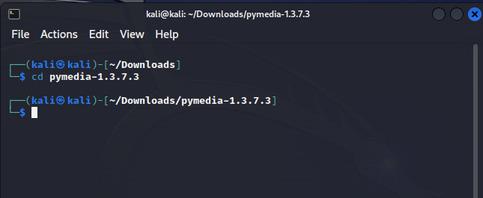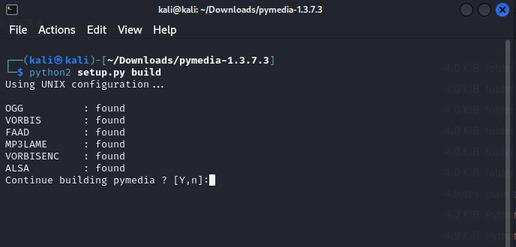Are you having doubts about Installing Python-PyMedia on your Linux System? If so, your search for the best installation guide ends here. This article covers all the insights about Python-PyMedia, its features, and installation. As you finish this article, you will have all the information required to get started with PyMedia. Let us delve into the world of multimedia processing with PyMedia.
The various industries across different sectors utilize multimedia applications for a variety of purposes such as handling, processing, and manipulating multimedia files. Thus, software experts need an efficient set of tools and libraries that help them in creating an interactive user experience through multimedia processing.
PyMedia is a Python library that is a popular choice among developers for this purpose. In this blog, we will learn about the PyMedia module in Python, its features, and its simple installation on your Linux System.
What is Python-PyMedia?
Python-PyMedia is a Python library for accessing and manipulating media files. It makes audio and video playback/creation so simple that even a newcomer to programming can learn it. It allows you to parse, demultiplex, multiplex, decode, and encode various file formats such as WAV, MP3, OGG, AVI, DivX, DVD, cdda, etc. But, before installing it, we should see some of its notable features.
Features of Python-PyMedia
1) It supports various packages:
PyMedia comes up with packages such as ‘audio’ which deals with audio processing, and ‘muxer’ which helps to identify and demux streams. Also, the ‘removable’ package contains a Set of modules to deal with the removable media and the ‘video’ package deals with the video processing
2) It supports encoding and decoding of multimedia files:
PyMedia supports encoding and decoding audio-compressed streams and video-compressed streams. It can also manipulate video to convert its frames between YUV and RGB formats
3) It can process multiple formats of multimedia:
For audio files, PyMedia supports MP3, MP2, WMA( v1 and v2 ), AC3, OGG( optional with Vorbis library ), and AAC( optional with faad library ) formats. On the other hand, it supports AVI(DivX, XviD), ASF( wmv1/2 ), MPEG1, and MPEG2( VCD, SVCD, DVD compatible ) formats for video files.
4) It can access CD/DVD files:
PyMedia supports direct CD/DVD ROM access to read audio/video tracks in a raw format. This allows us to play Audio, DVD, and Video CDs using the same interface.
5) PyMedia has various sound processing features:
You can do Sound mixer manipulation by listing all lines and getting the values of every line. It also has Sound manipulation classes such as SpectrAnalyzer, and Resampler that enable you to process the media files efficiently.
Prerequisites for PyMedia Installation
The basic PyMedia Installation does not require any external library or dependency. But, if you want to use its additional features, some dependencies are covered in the installation steps. Additionally, PyMedia is a Python-based library, so you must install Python on your system. We recommend installing Python version 2.3 or higher.
Additionally, if you want to play videos in the runtime, have to install install ‘pygame’ version 1.7 or higher. You can also install ‘pydfb’ version 1.0.2 or higher. Also, you should have a gcc compiler with version 3 to move ahead with installation on your Linux System. While installation, you may get some issues that arise due to dependency conflicts. So, make sure to install the dependencies with the correct versions.
Steps to Install PyMedia
Step 1: To Install Python 3 on your Linux system as shown below. You can skip this step if you have Python 2.3 or higher version installed.
sudo apt-get install python3

Step 2: Now, install the python-developer module using the command mentioned below which will manage the header files in the python applications.
‘sudo apt-get install python2-dev’

Step 3: Type the command mentioned below to install the libogg module.
sudo apt-get install libogg-dev

Step 4: Type the command mentioned below to install the libvorbis package.
sudo apt-get install libvorbis-dev

Step 5: Install the ‘mp3lame’ module using the command mentioned below.
sudo apt-get install libmp3lame-dev

Step 6: You now have to install the ‘libfaad’ module using the command as outlined below.
sudo apt-get install libfaad-dev

Step 7: Type the command mentioned below to install the libsound2 module which is required to install the ‘pyalsaaudio’ module.
sudo apt-get install libasound2-dev

Step 8: Now, we will install python-alsaaudio module. Type the below commands
- git clone https://github.com/larsimmisch/pyalsaaudio.git
- cd pyalsaaudio
- python setup.py build
- sudo python setup.py install
The terminal should appear as shown below:

Step 9: Download the tar file of Python-PyMedia by visiting the website https://sourceforge.net/projects/pymedia/files/pymedia/pymedia-1.3.7.3/ as shown below.

Step 10: Navigate to the folder where it has been downloaded and extract the files using the command as shown below:
tar xfz pymedia-1.3.7.3.tar.gz

Step 11: Change your current working directory to the folder that has been extracted as shown below:
cd pymedia-1.3.7.3

Step 12: Type the command to run the PyMedia build as shown below.
python2 setup.py build

Step 13: Now, run the command mentioned below to install the PyMedia library on your Linux system.
python2 setup.py install

Frequently Asked Questions
1) How to use PyMedia with PyCar Application?
To install the PyCar Application, We will need to first install its dependencies, Python-2.3+, and PyMedia-1.2.2.x, PyGame-1.6+( available on Windows/Linux ), or PyDfb-1.0.2(available on Linux only ), pyRXP. After this, you can install the PyCar Application and use the PyMedia Library.
2) What are the alternatives to the PyMedia library?
We can use MediaInfo, pyffmpeg, PyAV, and Pillow as alternatives to PyMedia in multimedia application development.
3) How to use the PyMedia library in my application?
Import the module using ‘import PyMedia’ and then use it as per your development requirements.
4) What is the latest version of PyMedia?
Its latest version was updated in 2006. You can visit the GitHub repository of PyMedia at https://github.com/pymedia/pymedia for more information about its versions.
5) Can I install PyMedia with Python version 3.10?
Yes, We can install and use PyMedia with Python’s latest versions such as 3.10 or higher. PyMedia is compatible with any Python version higher than 2.3.
6) Do other platforms support PyMedia Library?
Yes, PyMedia is currently supported on Linux x86, cygwin x86, Windows 2K, and XP operating systems.
7) What to do if the installed dependencies are not found?
Run the command ‘sudo apt-get update’ to update the package list on your system so that the dependencies can be found during installation.
Conclusion
PyMedia is a powerful cross-platform library of Python that allows us to develop multimedia applications with ease. It supports the processing of media files in multiple formats. It also possesses media access and sound processing capabilities. Due to its small size, it is a good choice for embedded multimedia software development.
Now, You have gained a clear understanding of PyMedia, its features, and applications along with its installation in your Linux environment. Go ahead and accelerate your multimedia software development with PyMedia.
Share your thoughts in the comments
Please Login to comment...